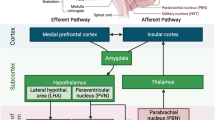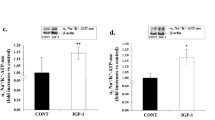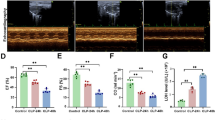Abstract
Angiotensin II type 1 receptor (AT1-R) and nuclear factor-kappaB (NF-κB) in the paraventricular nucleus (PVN) play important roles in heart failure (HF); however, the central mechanisms by which AT1-R and NF-κB contribute to sympathoexcitation in HF are yet unclear. In this study, we determined whether interaction between AT1-R and NF-κB in the PVN modulates neurotransmitters and contributes to NAD(P)H oxidase-dependent oxidative stress and sympathoexcitation in HF. Rats were implanted with bilateral PVN cannulae and subjected to coronary artery ligation or sham surgery (SHAM). Subsequently, animals were treated for 4 weeks through bilateral PVN infusion with either vehicle or losartan (LOS, 10 μg/h), an AT1-R antagonist; or pyrrolidine dithiocarbamate (PDTC, 5 μg/h), a NF-κB inhibitor via osmotic minipump. Myocardial infarction (MI) rats had higher levels of glutamate (Glu), norepinephrine (NE) and NF-κB p65 activity, lower levels of gamma-aminobutyric acid (GABA), and more positive neurons for phosphorylated IKKβ and gp91phox (a subunit of NAD(P)H oxidase) in the PVN when compared to SHAM rats. MI rats also had higher levels of renal sympathetic nerve activity (RSNA) and plasma proinflammatory cytokines (PICs), NE and epinephrine. PVN infusions of LOS or PDTC attenuated the decreases in GABA and the increases in gp91phox, NF-κB activity, Glu and NE, in the PVN of HF rats. PVN infusions of LOS or PDTC also attenuated the increases in RSNA and plasma PICs, NE and epinephrine in MI rats. These findings suggest that interaction between AT1 receptor and NF-κB in the PVN contributes to oxidative stress and sympathoexcitation by modulating neurotransmitters in heart failure.






Similar content being viewed by others
References
Dampney, R. A., Fontes, M. A., Hirooka, Y., Horiuchi, J., Potts, P. D., & Tagawa, T. (2002). Role of angiotensin II receptors in the regulation of vasomotor neurons in the ventrolateral medulla. Clinical and Experimental Pharmacology and Physiology, 29, 467–472.
Zhu, G. Q., Gao, L., Li, Y., Patel, K. P., Zucker, I. H., & Wang, W. (2004). AT1 receptor mRNA antisense normalizes enhanced cardiac sympathetic afferent reflex in rats with chronic heart failure. American Journal of Physiology-Heart and Circulatory Physiology, 287, H1828–H1835.
Francis, J., Wei, S. G., Weiss, R. M., & Felder, R. B. (2004). Brain angiotensin-converting enzyme activity and autonomic regulation in heart failure. American Journal of Physiology-Heart and Circulatory Physiology, 287, H2138–H2146.
Wang, H., Huang, B. S., Ganten, D., & Leenen, F. H. (2004). Prevention of sympathetic and cardiac dysfunction after myocardial infarction in transgenic rats deficient in brain angiotensinogen. Circulation Research, 94, 843–849.
Zhang, Z. H., Wei, S. G., Francis, J., & Felder, R. B. (2003). Cardiovascular and renal sympathetic activation by blood-borne TNF-alpha in rat: The role of central prostaglandins. American Journal of Physiology: Regulatory, Integrative and Comparative Physiology, 284, R916–R927.
Agarwal, D., Welsch, M. A., Keller, J. N., & Francis, J. (2011). Chronic exercise modulates RAS components and improves balance between pro- and anti-inflammatory cytokines in the brain of SHR. Basic Research in Cardiology, 106, 1069–1085.
Chappell, D., Hofmann-Kiefer, K., Jacob, M., Rehm, M., Briegel, J., Welsch, U., et al. (2009). TNF-alpha induced shedding of the endothelial glycocalyx is prevented by hydrocortisone and antithrombin. Basic Research in Cardiology, 104, 78–89.
Chorianopoulos, E., Heger, T., Lutz, M., Frank, D., Bea, F., Katus, H. A., et al. (2010). FGF-inducible 14-kDa protein (Fn14) is regulated via the RhoA/ROCK kinase pathway in cardiomyocytes and mediates nuclear factor-kappaB activation by TWEAK. Basic Research in Cardiology, 105, 301–313.
Lacerda, L., McCarthy, J., Mungly, S. F., Lynn, E. G., Sack, M. N., Opie, L. H., et al. (2010). TNFα protects cardiac mitochondria independently of its cell surface receptors. Basic Research in Cardiology, 105, 751–762.
Li, S., Zhong, S., Zeng, K., Luo, Y., Zhang, F., Sun, X., et al. (2010). Blockade of NF-kappaB by pyrrolidine dithiocarbamate attenuates myocardial inflammatory response and ventricular dysfunction following coronary microembolization induced by homologous microthrombi in rats. Basic Research in Cardiology, 105, 139–150.
Zhang, C., Wu, J., Xu, X., Potter, B. J., & Gao, X. (2010). Direct relationship between levels of TNF-alpha expression and endothelial dysfunction in reperfusion injury. Basic Research in Cardiology, 105, 453–464.
Valen, G., Yan, Z. Q., & Hansson, G. K. (2001). Nuclear factor kappa-B and the heart. Journal of the American College of Cardiology, 38, 307–314.
Bhakar, A. L., Tannis, L. L., Zeindler, C., Russo, M. P., Jobin, C., Park, D. S., et al. (2002). Constitutive NF-κB activity is required for central neuron survival. Journal of Neuroscience, 22, 8466–8475.
Gloire, G., Legrand-Poels, S., & Piette, J. (2006). NF-kappaB activation by reactive oxygen species: Fifteen years later. Biochemical Pharmacology, 72, 1493–1505.
Kang, Y. M., Ma, Y., Elks, C., Zheng, J. P., Yang, Z. M., & Francis, J. (2008). Cross-talk between cytokines and renin-angiotensin in hypothalamic paraventricular nucleus in heart failure: Role of nuclear factor-kappaB. Cardiovascular Research, 79, 671–678.
Kang, Y. M., He, R. L., Yang, L. M., Qin, D. N., Guggilam, A., Elks, C., et al. (2009). Brain tumour necrosis factor-alpha modulates neurotransmitters in hypothalamic paraventricular nucleus in heart failure. Cardiovascular Research, 83, 737–746.
Francis, J., MohanKumar, S. M., & MohanKumar, P. S. (2000). Correlations of norepinephrine release in the paraventricular nucleus with plasma corticosterone and leptin after systemic lipopolysaccharide: Blockade by soluble IL-1 receptor. Brain Research, 867, 180–187.
Paxinos, G., Watson, C. R., & Emson, P. C. (1986). The rat brain in stereotaxic coordinates. San Diego, CA: Academic.
Kang, Y. M., Zhang, Z. H., Johnson, R. F., Yu, Y., Beltz, T., Johnson, A. K., et al. (2006). Novel effect of mineralocorticoid receptor antagonism to reduce proinflammatory cytokines and hypothalamic activation in rats with ischemia-induced heart failure. Circulation Research, 99, 758–766.
Francis, J., Weiss, R. M., Wei, S. G., Johnson, A. K., Beltz, T. G., Zimmerman, K., et al. (2001). Central mineralocorticoid receptor blockade improves volume regulation and reduces sympathetic drive in heart failure. American Journal of Physiology-Heart and Circulatory Physiology, 281, H2241–H2251.
Nagura, S., Sakagami, T., Kakiichi, A., Yoshimoto, M., & Miki, K. (2004). Acute shifts in baroreflex control of renal sympathetic nerve activity induced by REM sleep and grooming in rats. Journal of Physiology, 558, 975–983.
Guggilam, A., Haque, M., Kerut, E. K., McIlwain, E., Lucchesi, P., Seghal, I., et al. (2007). TNF-alpha blockade decreases oxidative stress in the paraventricular nucleus and attenuates sympathoexcitation in heart failure rats. American Journal of Physiology-Heart and Circulatory Physiology, 293, H599–H609.
Liu, J. L., Irvine, S., Reid, I. A., Patel, K. P., & Zucker, I. H. (2000). Chronic exercise reduces sympathetic nerve activity in rabbits with pacing-induced heart failure: A role for angiotensin II. Circulation, 102, 1854–1862.
Kang, Y. M., Wang, Y., Yang, L. M., Elks, C., Cardinale, J., Yu, X. J., et al. (2010). TNF-α in hypothalamic paraventricular nucleus contributes to sympathoexcitation in heart failure by modulating AT1 receptor and neurotransmitters. Tohoku Journal of Experimental Medicine, 222, 251–263.
MohanKumar, S. M., MohanKumar, P. S., & Quadri, S. K. (1998). Specificity of interleukin-1beta-induced changes in monoamine concentrations in hypothalamic nuclei: Blockade by interleukin-1 receptor antagonist. Brain Research Bulletin, 47, 29–34.
Barber, M., Kasturi, B. S., Austin, M. E., Patel, K. P., MohanKumar, S. M., & MohanKumar, P. S. (2003). Diabetes-induced neuroendocrine changes in rats: Role of brain monoamines, insulin and leptin. Brain Research, 964, 128–135.
Yang, L. M., Hu, B., Xia, Y. H., Zhang, B. L., & Zhao, H. (2008). Lateral habenula lesions improve the behavioral response in depressed rats via increasing the serotonin level in dorsal raphe nucleus. Behavioural Brain Research, 188, 84–90.
Guggilam, A., Patel, K. P., Haque, M., Ebenezer, P. J., Kapusta, D. R., & Francis, J. (2008). Cytokine blockade attenuates sympathoexcitation in heart failure: Cross-talk between nNOS, AT-1R and cytokines in the hypothalamic paraventricular nucleus. European Journal of Heart Failure, 10, 625–634.
Kang, Y. M., Zhang, A. Q., Zhao, X. F., Cardinale, J. P., Elks, C., Cao, X. M., et al. (2011). Paraventricular nucleus corticotrophin releasing hormone contributes to sympathoexcitation via interaction with neurotransmitters in heart failure. Basic Research in Cardiology, 106, 473–483.
Qi, J., Zhang, D. M., Suo, Y. P., Song, X. A., Yu, X. J., Elks, C., et al. (2013). Renin-Angiotensin System Modulates Neurotransmitters in the Paraventricular Nucleus and Contributes to Angiotensin II-Induced Hypertensive Response. Cardiovascular Toxicology, 13, 48–54.
Zheng, M., Kang, Y. M., Liu, W., Zang, W. J., Bao, C. Y., & Qin, D. N. (2012). Inhibition of cyclooxygenase-2 reduces hypothalamic excitation in rats with adriamycin-induced heart failure. PLoS ONE, 7, e48771.
Kang, Y. M., Ma, Y., Zheng, J. P., Elks, C., Sriramula, S., Yang, Z. M., et al. (2009). Brain nuclear factor-kappa B activation contributes to neurohumoral excitation in angiotensin II-induced hypertension. Cardiovascular Research, 82, 503–512.
Kang, Y. M., Zhang, Z. H., Xue, B., Weiss, R. M., & Felder, R. B. (2008). Inhibition of brain proinflammatory cytokine synthesis reduces hypothalamic excitation in rats with ischemia-induced heart failure. American Journal of Physiology-Heart and Circulatory Physiology, 295, H227–H236.
Aguilera, G., Young, W. S., Kiss, A., & Bathia, A. (1995). Direct regulation of hypothalamic corticotropin-releasing-hormone neurons by angiotensin II. Neuroendocrinology, 61, 437–444.
Jezova, D., Ochedalski, T., Kiss, A., & Aguilera, G. (1998). Brain angiotensin II modulates sympathoadrenal and hypothalamic pituitary adrenocortical activation during stress. Journal of Neuroendocrinology, 10, 67–72.
Schwarz, M., Schmitt, T., Pergande, G., & Block, F. (1995). N-methyl-D-aspartate and alpha 2-adrenergic mechanisms are involved in the depressant action of flupirtine on spinal reflexes in rats. European Journal of Pharmacology, 276, 247–255.
Swanson, L. W., & Sawchenko, P. E. (1983). Hypothalamic integration: Organization of the paraventricular and supraoptic nuclei. Annual Review of Neuroscience, 6, 269–324.
Zucker, I. H. (2006). Novel mechanisms of sympathetic regulation in chronic heart failure. Hypertension, 48, 1005–1011.
Cowling, R. T., Gurantz, D., Peng, J., Dillmann, W. H., & Greenberg, B. H. (2002). Transcription factor NF-kappa B is necessary for up-regulation of type 1 angiotensin II receptor mRNA in rat cardiac fibroblasts treated with tumor necrosis factor-alpha or interleukin-1 beta. Journal of Biological Chemistry, 277, 5719–5724.
Chen, Z. J., Parent, L., & Maniatis, T. (1996). Site-specific phosphorylation of IkappaBalpha by a novel ubiquitination-dependent protein kinase activity. Cell, 84, 853–862.
van den, B. R., Haenen, G. R., van den, B. H., & Bast, A. (2001). Transcription factor NF-κB as a potential biomarker for oxidative stress. British Journal of Nutrition, 86, S121–S127.
Swanson, L. W., & Sawchenko, P. E. (1980). Paraventricular nucleus: A site for the integration of neuroendocrine and autonomic mechanisms. Neuroendocrinology, 31, 410–417.
Hermes, M. L., Coderre, E. M., Buijs, R. M., & Renaud, L. P. (1996). GABA and glutamate mediate rapid neurotransmission from suprachiasmatic nucleus to hypothalamic paraventricular nucleus in rat. Journal of Physiology, 496, 749–757.
Tasker, J. G., Boudaba, C., & Schrader, L. A. (1998). Local glutamatergic and GABAergic synaptic circuits and metabotropic glutamate receptors in the hypothalamic paraventricular and supraoptic nuclei. Advances in Experimental Medicine and Biology, 449, 117–121.
Antonaccio, M. J., Kerwin, L., & Taylor, D. G. (1978). Reductions in blood pressure, heart rate and renal sympathetic nerve discharge in cats after the central administration of muscimol, a GABA agonist. Neuropharmacology, 17, 783–791.
Brennan, T. J., Haywood, J. R., & Ticku, M. K. (1983). GABA receptor binding and hemodynamic responses to ICV GABA in adult spontaneously hypertensive rats. Life Sciences, 33, 701–709.
Arabia, A. M., Catapano, L., Storini, C., Perego, C., De Luigi, A., Head, G. A., et al. (2002). Impaired central stress-induced release of noradrenaline in rats with heart failure: A microdialysis study. Neuroscience, 114, 591–599.
Basu, S., Sinha, S. K., Shao, Q., Ganguly, P. K., & Dhalla, N. S. (1996). Neuropeptide Y modulation of sympathetic activity in myocardial infarction. Journal of the American College of Cardiology, 27, 1796–1803.
Chen, Q. H., Haywood, J. R., & Toney, G. M. (2003). Sympathoexcitation by PVN-injected bicuculline requires activation of excitatory amino acid receptors. Hypertension, 42, 725–731.
Cole, R. L., & Sawchenko, P. E. (2002). Neurotransmitter regulation of cellular activation and neuropeptide gene expression in the paraventricular nucleus of the hypothalamus. Journal of Neuroscience, 22, 959–969.
Zhang, K., Li, Y. F., & Patel, K. P. (2002). Reduced endogenous GABA-mediated inhibition in the PVN on renal nerve discharge in rats with heart failure. American Journal of Physiology: Regulatory, Integrative and Comparative Physiology, 282, R1006–R1015.
Kleiber, A. C., Zheng, H., Schultz, H. D., Peuler, J. D., & Patel, K. P. (2008). Exercise training normalizes enhanced glutamate-mediated sympathetic activation from the PVN in heart failure. American Journal of Physiology: Regulatory, Integrative and Comparative Physiology, 294, R1863–R1872.
Patel, K. P. (2000). Role of paraventricular nucleus in mediating sympathetic outflow in heart failure. Heart Failure Reviews, 5, 73–86.
Dampney, R. A., Horiuchi, J., Killinger, S., Sheriff, M. J., Tan, P. S., & McDowall, L. M. (2005). Long-term regulation of arterial blood pressure by hypothalamic nuclei: Some critical questions. Clinical and Experimental Pharmacology and Physiology, 32, 419–425.
Acknowledgments
This study was supported by National Basic Research Program of China (No. 2012CB517805), National Natural Science Foundation of China (Nos. 81170248, 81070199, 31171095) and Research Fund for the Doctoral Program of Higher Education of China (No. 20101417110002).
Conflict of interest
None.
Author information
Authors and Affiliations
Corresponding author
Additional information
Xiao-Jing Yu and Yu-Ping Suo have contributed equally to this study.
Rights and permissions
About this article
Cite this article
Yu, XJ., Suo, YP., Qi, J. et al. Interaction Between AT1 Receptor and NF-κB in Hypothalamic Paraventricular Nucleus Contributes to Oxidative Stress and Sympathoexcitation by Modulating Neurotransmitters in Heart Failure. Cardiovasc Toxicol 13, 381–390 (2013). https://doi.org/10.1007/s12012-013-9219-x
Published:
Issue Date:
DOI: https://doi.org/10.1007/s12012-013-9219-x




